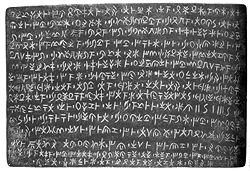- Cypriot syllabary
-
Cypriot 
Type Syllabary Languages Cypriot Greek, Eteocypriot Time period 11th–4th centuries BCE Parent systems Linear A- Cypro-Minoan
- Cypriot
ISO 15924 Cprt, 403 Direction Right-to-left Unicode alias Cypriot Unicode range U+10800–U+1083F Note: This page may contain IPA phonetic symbols. The Cypriot syllabary is a syllabic script used in Iron Age Cyprus, from ca. the 11th to the 4th centuries BCE, when it was replaced by the Greek alphabet. A pioneer of that change was king Evagoras of Salamis. It is descended from the Cypro-Minoan syllabary, in turn a variant or derivative of Linear A.
Contents
Origin
The island of Cyprus has always been known to possess its own script during the classical period. The Cypriot Syllabary however, only refers to the script used during iron age Greece. The script used during bronze age Greece is generally known as Cypro-Minoan script.[1] Most texts using the script are in the Arcadocypriot dialect of Greek, but some bilingual (Greek and Eteocypriot) inscriptions were found in Amathus.
Evolution
It has been established that the Cypriot Syllabary is derived from the Linear A script and most probably, the Minoan writing system. The most obvious change is the disappearance of ideograms, which were frequent and represented a significant part of Linear A.[2] The earliest inscriptions are found on clay tablets. Parallel to the evolution of cuneiform, the signs soon became simple patterns of lines. There are some evidence of a Semitic influence due to trade, but this pattern seemed to have evolved as the result of habitual use.[1]
Structure
The structure of Cypriot Syllabary is very similar to that of Linear B. This is due to their common origin and underlying language (albeit different dialects).[1] The Cypriot script contains 56 signs.[3] Each sign generally stands for a syllable in the spoken language: e.g. ka, ke, ki, ko, ku etc. Hence, it is classified as a syllabic writing system.[2] Because each sign stands for an open syllable (CV) rather than a closed one (CVC), the Cypriot syllabary is also an 'open' syllabary.[3]
-a -e -i -o -u
Wikimedia Foundation. 2010.
Look at other dictionaries:
Cypriot syllabary — a syllabic script in use on Cyprus in the first millennium B.C., used for the writing of Greek and of an unknown language. * * * ▪ linguistics system of writing used on the island of Cyprus, chiefly from the 6th to the 3rd century BC. The… … Universalium
cypriot syllabary — noun Usage: usually capitalized C : a syllabary prob. of Aegean origin in which ancient Cypriot is preserved * * * a syllabic script in use on Cyprus in the first millennium B.C., used for the writing of Greek and of an unknown language … Useful english dictionary
Cypriot Greek — This article is about the modern Greek dialect of Cyprus. For the ancient Greek dialect, see Arcadocypriot. History of the Greek language (see also: Greek alphabet) Proto Greek (c. 3000–1600 BC) … Wikipedia
Cypro-Minoan syllabary — Cypro Minoan Type Syllabary Languages unknown … Wikipedia
Cherokee syllabary — Cherokee Type Syllabary Languages Cherokee language Time period 1820s … Wikipedia
Greek language — Greek Ελληνικά Ellīniká Pronunciation [eliniˈka] Spoken in Greece, Cyprus … Wikipedia
Linear B — Infobox Writing system name=Linear B type=Syllabary typedesc=with additional Logograms time=Late Bronze Age status=Extinct languages=Mycenaean Greek fam1= Linear A sisters=Cypro Minoan syllabary unicode=… … Wikipedia
Prehistoric Cyprus — History of Cyprus This article is part of a series Timeline … Wikipedia
Arcadocypriot Greek — Distribution of Greek dialects in the classical period.[1] Western group … Wikipedia
Eteocypriot — language name=Eteocypriot nativename=? familycolor=?Unknown states=Formerly spoken in Cyprus region=Eastern Mediterranean Sea extinct=effectively extinct from about the beginning of the 4th century BCE, family=Language isolate or unknown… … Wikipedia
- Cypro-Minoan

